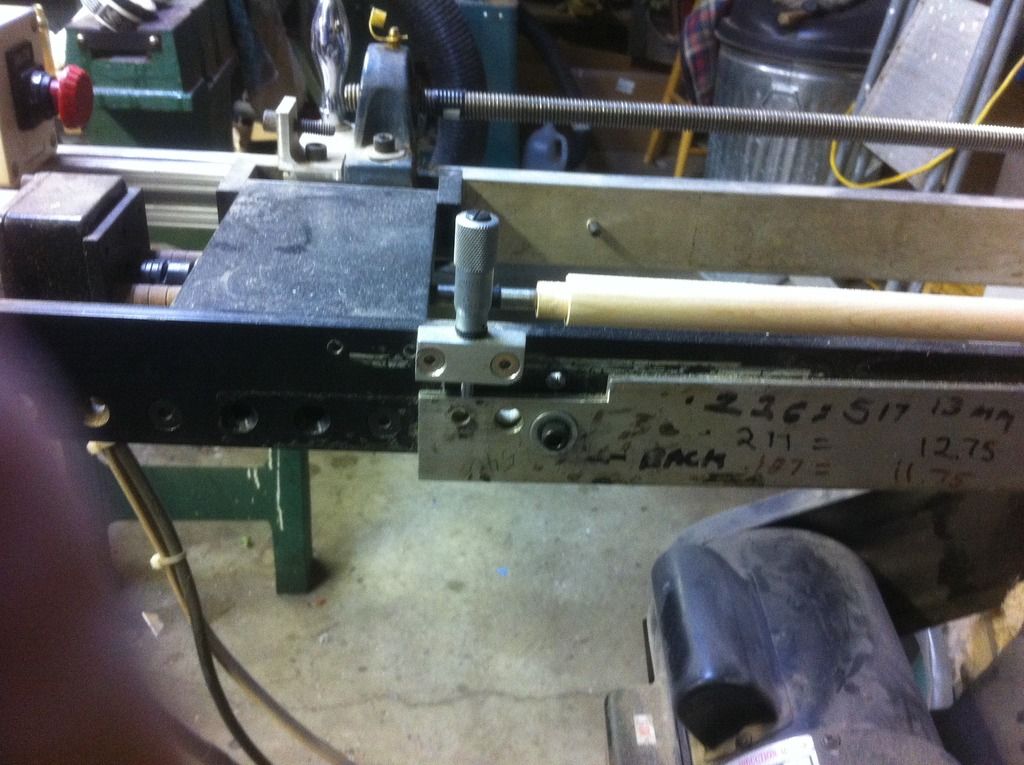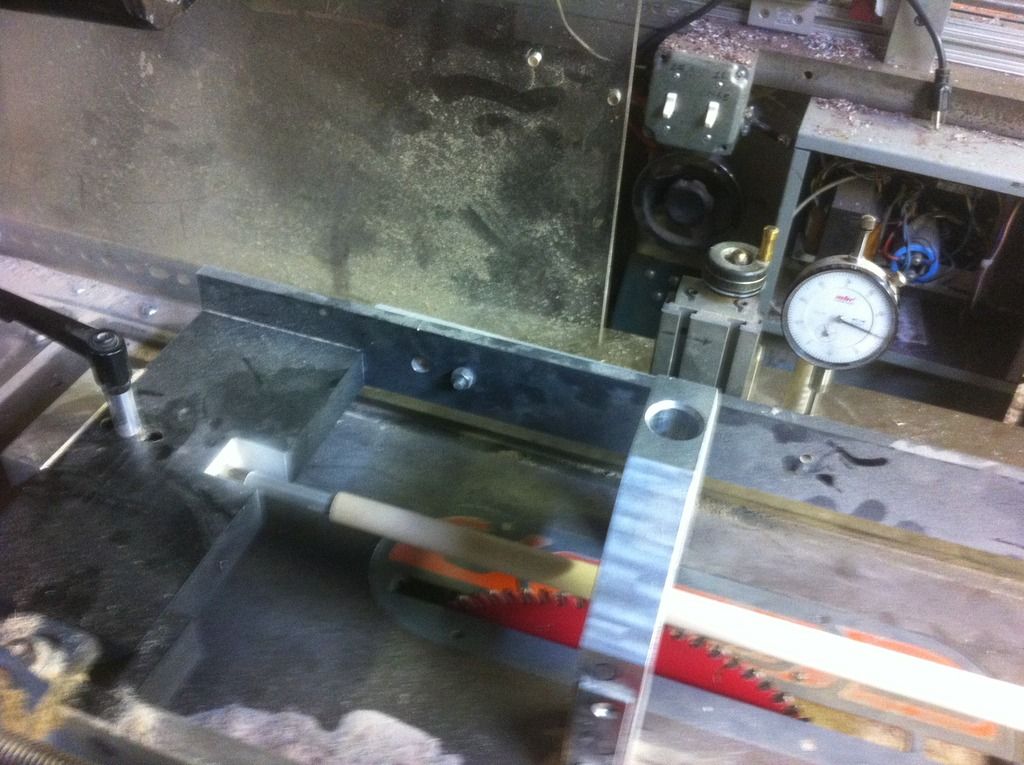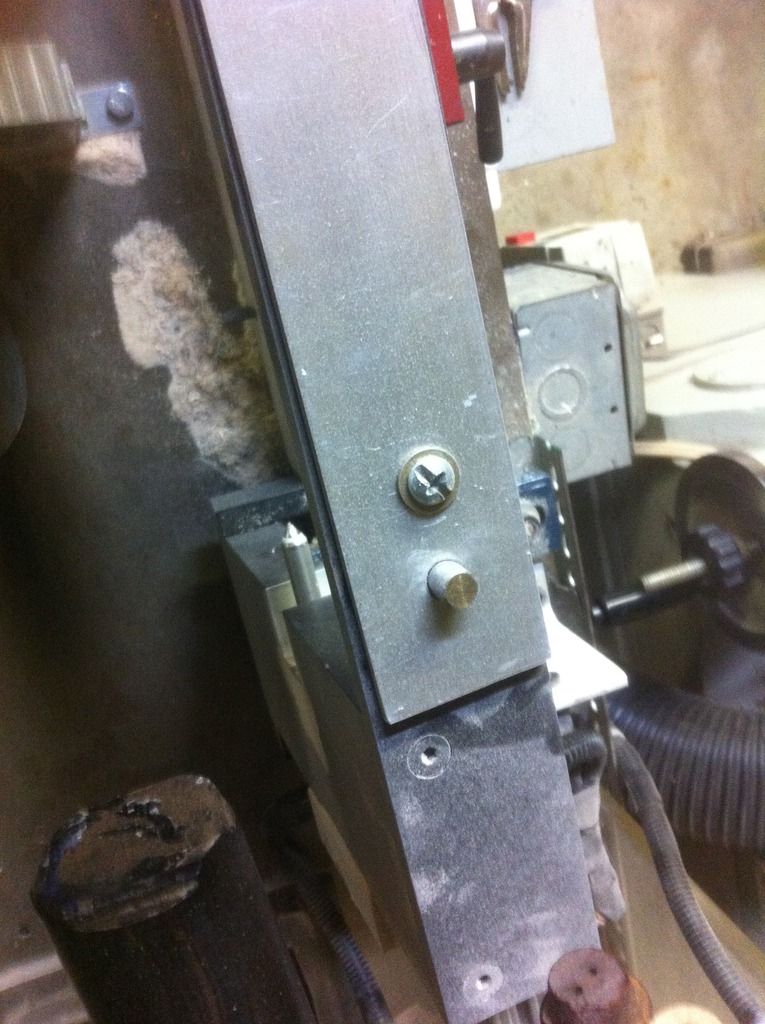[...]
I learned since then, fast ball screws and xylotex controller were not the best of components for our use.
Truer words were never spoke.
TW
[...]
I learned since then, fast ball screws and xylotex controller were not the best of components for our use.
I would agree --you get alot of bang for your buck --with his cnc tapering.
Joe
Stay agreeable, my friends.
TW
Tapering shafts with my Deluxe Cuesmith lathe is kinda cumbersome.
I think I would like to have a more dedicated tapering setup.
I`ve been looking at buying a 4 axis CNC and using that for tapering instead of the lathe.
Is CNC the way to go or should I look at machines like the Taper Shaper from Unique?
I PMed Kim to ask why he was finding it cumbersome to taper with his lathe. He said he is getting good tapering cuts, but finds it difficult to keep readjusting the taper bar to experiment with different tapers. I have a 4 head CNC tapering machine myself that Bludworth built for me years ago. It does make changing tapers on shafts pretty simple. So a dedicated CNC tapering machine makes the most sense if you want unlimited tapers.
If the budget or space does not allow a separate CNC machine then my suggestion is add the removable shaft taper bar option to your lathe and buy additional taper bars. That way once you get one set like you like it for one shaft taper you can mark it and put another one on and set it up for a different taper. Most cuemakers have found that 3 or 4 shaft tapers works out pretty well. You can also adjust joint size to match the different tip diameters simply by adjusting how far your dead center is sticking out of your headstock. So the additional taper bars are just for stiffness profiles and not needed for different tip diameters.
Chris,
Once he establishes his tapers, why can't he remove the adjustable bar from your machine and just drop in a bar with a indexed pivot point and indicator on the other side to adjust the differential between the joint and tip size. This way he can change the tip size while hold his joint size?
His butt taper bar could also be plug and play indexed to the same pivot point. Very simple.
My friend has a deluxe and he gets very nice shaft performance production so I don't think Kim needs another machine.
I think that having a few dedicated taper bars made would save him money and give 100% repeatability without needing extra shop space.
JMO,
Rick
That is another way that would work. Good idea.
Actually, the idea of a taper bar that pivots at the "joint" end is not really very well thought out at all.
Suppose your taper bar is set up for a "pro" taper where the last 10 inches is a straight cylinder. The premise of pivoting at the joint end (to keep the joint diameter consistent) means any size tip that varies from the original design diameter will no longer have that straight section at the business end.
For example, if the design model is based on a 13mm tip, and the customer wants a 12.5mm instead, the last 10 inches will necessarily be conical, rather than cylindrical. Alternately, if the customer wants a 13.5mm, the last 10 inches will actual flare outward - which is even LESS desirable.
Also - and a lot of newer cuemakers may not know this - slightly altering the shoulder section of a shaft can make a HUGE difference to how the shaft plays. So not only is the pivoting taper bar going to potentially change the "stroked" portion of the shaft, it's also going to change the overall action of the shaft all the way back to the joint.
No matter what your carefully designed taper happens to be, as soon as you start pivoting the taper bar at the joint end you will be altering the entire shaft profile far more than you probably would want to.
For that reason it's a bad idea, as any competent cuemaker would discover when he tried to actually put it into practice. I seriously doubt the results would suit an experienced maker who cares about the geometry of his taper(s).
TW
(PS: In anticipation of the argument that any variation in the shaft taper (caused by the silly "pivoting bar" idea) can be resolved by "sanding it out", let me point out that if this less-than-precise solution is acceptable then forget the idea of any adjustment at all, and simply sand ALL your shafts to the individual tapers you think you want.)
Really,
I have found that one taper bar with a pivot for 13mm to 12.75 works well on my pro taper and super pro tapers. If you go further than that differential between the joint size and the tip geometry at some point it will get straight and with more pivot there is actually a reversal of the taper. Not something you wish. One must understand this before he can control desired outcomes. You can't use the same pivoted bar for 13MM and pivot to 12.25, no way. That would be foolish. Tapers are tricky business and need a lot of circumspect attention to detail. If you have to sand your final taper turn to accomplish a procedure fit, you need to go back to the drawing board.
I have plotted and cut tapper bars on my CNC mill that allows me to build shafts to 11 mm while maintaining climb in the front and the correct joint dia with the use of compound tapering with engineered intermediate taper joining sections. These profiles throughout the 13mm to 11mm don't not have the appearance of a tapered shaft for 23 inches or so then gets fat very quick.
I do disagree however with your talk about sanding the shoulder or whatever it was you were saying. I believe that a good shaft taper should be compounded with an intermediate equalization taper section in the center area. This way the climb in the first 12 to 14" and the initial taper geometry from the joint to the intermediate section can be somewhat uniform on shafts with different tip sizes, never needing any sanding at the joint area. My 13mm or my 11mm shafts have the same parabolic profile look for the first 5 inches. Without sanding of any kind.
What's more is that every time a tip size is changed, the differential math to the joint is changed, you have to change or quantize the total shaft geometry. Each tip size and taper geometry is exclusive unto itself.
CNC formed shafts or CNC formed taper bars with a pivot, you still must be flying the airplane concerning performance evaluation and finish contour after the final pass on each specific size required. There is no automatic pilot here. Each specific geometry and tip size must be well planed and tested by the replete cue maker me thinks.
This is an art and the most important item effecting the way your cue performs. No one way or method is better than another. The final taper turn on each taper and tip size is exclusive to that individual shaft geometry only. As I said tapers are tricky. It took me many years to understand where the rubber meets to road.
You can build the best butt blank in the world, if you don't have shafts that perform, your an also run. The more attention paid in this area is directly proportional to overall performance.
Just my opinion,
Rick
Someone with a Chris Hightower adjustable taper bar can create the best playing taper ever made for let's say 13 mm. If he wants to do one at 12.75 he must change that set up. Buy going to a bar that will pivot and accommodate two is just one way to skin a cat.
The OP could have one taper bar made with a centered pivot. On side of the bar could be a straight line for his butt geometry and the other side could be his taper geometry for a13mm shaft. He could then adjust on the pivot giving him the option of 13mm or 12.75 in a minute or so with exacting repeatability. No need to buy a new machine and no extra shop space required. Job done !
Rick
If you pivot off the joint end then you don't have a pro taper anymore. The straight portion will be conical
My pivot is on the tip end.
What happens to the joint collar size?
If you're only taking down 13 to 12.75MM, there's no need to touch the taper bar.
Just fade out after 20 inches or so till you get to the 23-24" mark with the dial.
I must have a different interpretation of PIVOT POINT.
If you have a stopper/hinge on the joint end, that's the pivot point for me .



[...]
I do disagree however with your talk about sanding the shoulder or whatever it was you were saying. I believe that a good shaft taper should be compounded with an intermediate equalization taper section in the center area. This way the climb in the first 12 to 14" and the initial taper geometry from the joint to the intermediate section can be somewhat uniform on shafts with different tip sizes, never needing any sanding at the joint area. My 13mm or my 11mm shafts have the same parabolic profile look for the first 5 inches. Without sanding of any kind.
What's more is that every time a tip size is changed, the differential math to the joint is changed, you have to change or quantize the total shaft geometry. Each tip size and taper geometry is exclusive unto itself.
CNC formed shafts or CNC formed taper bars with a pivot, you still must be flying the airplane concerning performance evaluation and finish contour after the final pass on each specific size required. There is no automatic pilot here. Each specific geometry and tip size must be well planed and tested by the replete cue maker me thinks.
This is an art and the most important item effecting the way your cue performs. No one way or method is better than another. The final taper turn on each taper and tip size is exclusive to that individual shaft geometry only. [...]
My pivots are on the tip ends Jake.
But you just recommended having a taper bar that pivots on the JOINT end. Now the pivot should be at the tip end instead?
No matter - the problem remains. A pivot anywhere on a shaft taper bar will affect the entire shaft - not just the tip or joint size. If the accuracy and repeatability of any shaft profile matters to a cuemaker he would be far better off having a distinct taper bar for each shaft size and/or design, OR use CNC (the best choice).
A pivoting taper bar for cutting shafts is simply a bad idea, unless the maker is willing to do a lot of hand sanding afterwards, and can live with the imprecise results.
TW

But you just recommended having a taper bar that pivots on the JOINT end. Now the pivot should be at the tip end instead?
No matter - the problem remains. A pivot anywhere on a shaft taper bar will affect the entire shaft - not just the tip or joint size. If the accuracy and repeatability of any shaft profile matters to a cuemaker he would be far better off having a distinct taper bar for each shaft size and/or design, OR use CNC (the best choice).
A pivoting taper bar for cutting shafts is simply a bad idea, unless the maker is willing to do a lot of hand sanding afterwards, and can live with the imprecise results.
TW